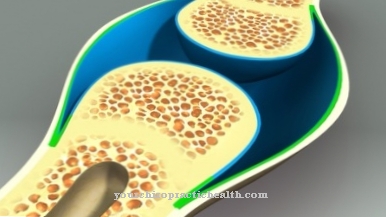Of the Swallowing reflex is an alien reflex of the human body that enables it to ingest food and fluids. The process is also known as the act of swallowing. The process is very complex and necessary for our survival.
What is the swallow reflex?

The swallowing reflex is innate and reflexively controlled. This reflex is essential for ingesting and transporting food. People swallow between 1,000 and 3,000 times a day. When the food is absorbed through the oral cavity, it then reaches the esophagus.
Swallowing is triggered by touching the palatal arches, tongue and the back of the pharynx. While the person swallows, breathing stops. This act is regulated by the swallowing center located in the brain stem. The act of swallowing can also be impaired and is called a swallowing disorder.
Depending on the type of food that a person eats, the size and duration of the swallow varies.The duration depends on how well the food was chewed and mixed with saliva. On average, the swallowing process takes between 8 and 20 seconds.
Function & task
The swallowing process is divided into individual phases. Each of these phases has its own task to perform.
The preparatory phase describes the processes that make the actual swallowing process possible. The food must first be sufficiently chewed and mixed with saliva so that the food bolus can slide through the esophagus.
The transport phase is the second step of the reflex. When the mouth is closed, to prevent saliva loss and to avoid swallowing additional air, the tongue presses against the roof of the mouth and the swallowing process is triggered. The food bolus is transported into the throat via the throat constriction. The muscles of the tongue provide the trigger in wave-shaped applications. Swallowing is triggered when the base of the tongue or the back of the throat is touched by the food bolus.
In the pharyngeal transport phase, the upper and lower airways are sealed. This prevents the pulp from entering the nose and possible swallowing. When swallowing, there is an equalization of pressure in the middle ear and external pressure. This happens when the soft palate is tense and the eustachian tube widens as a result.
If the nasopharynx is not closed when swallowing, chyme can get into the airways. The larynx must also be closed by the epiglottis. The upper pharyngeal cords (musculus constrictor pharyngis superior) contract and thus the airways are completely closed. The vocal folds are closed, the epiglottis sinks and the muscles of the floor of the mouth contracts. As the larynx steps higher, the epiglottis and larynx entrance approach, so that the lower airways are protected in three ways. The upper esophageal sphincter opens and food can be transported.
In the last phase, the esophageal transport phase, the muscle closes again. The food bolus has landed in the esophagus. The airways are opened again. The bolus takes its usual course. The stomach mouth opens, and after the bolus hits the stomach, it closes again. The act of swallowing is over.
You can find your medication here
➔ Medicines for sore throats and difficulty swallowingIllnesses & ailments
During pregnancy, the child's act of swallowing develops. But if there are malformations in the central nervous system or in the digestive tract, the swallowing reflex is disturbed. Swallowing difficulties can also occur in older people.
Symptoms associated with swallowing disorder are often a feeling of lump in the throat, gag reflex when swallowing, or coughing while eating.
The cause of an existing swallowing disorder can be a psychological cause, but also a side effect of a neurological or chronic disease. Review is especially important in patients with multiple sclerosis or ALS. Other physical causes that impair the swallowing reflex include injuries and tumors.
Difficulty swallowing is often a side effect of a severe cold or tonsillitis. The swelling of the mucous membranes makes swallowing difficult.
A neurogenic disorder is the most common cause of impaired swallowing reflex. After a stroke, meningitis or an illness such as Parkinson's. Swallowing difficulties also occur with muscle wasting, a disease of the muscles.
Difficulties swallowing are very common with tumors or after operations in the throat, mouth and head area. If the neck and esophagus are in contact with a foreign body for a long period of time, dysphagia occurs. The same can be caused by poisoning or chemotherapy.
In younger patients, the problems are psychological. Those affected always have the feeling of having a lump in their throat. Children often suffer from congenital malformations.
In older people, it decreases efficiently when swallowing. In presbyphagia, the reaction time of the muscles is slowed. Tooth loss and dried out mucous membranes make swallowing difficult. Swallowing disorders can also occur as a side effect of dementia.












.jpg)



.jpg)










.jpg)
